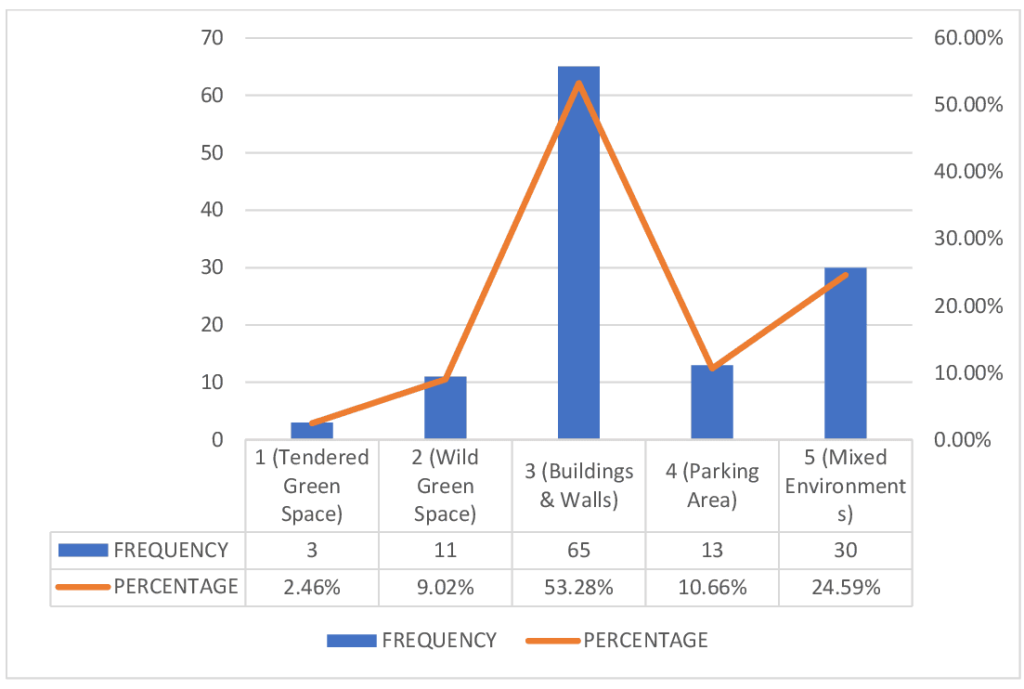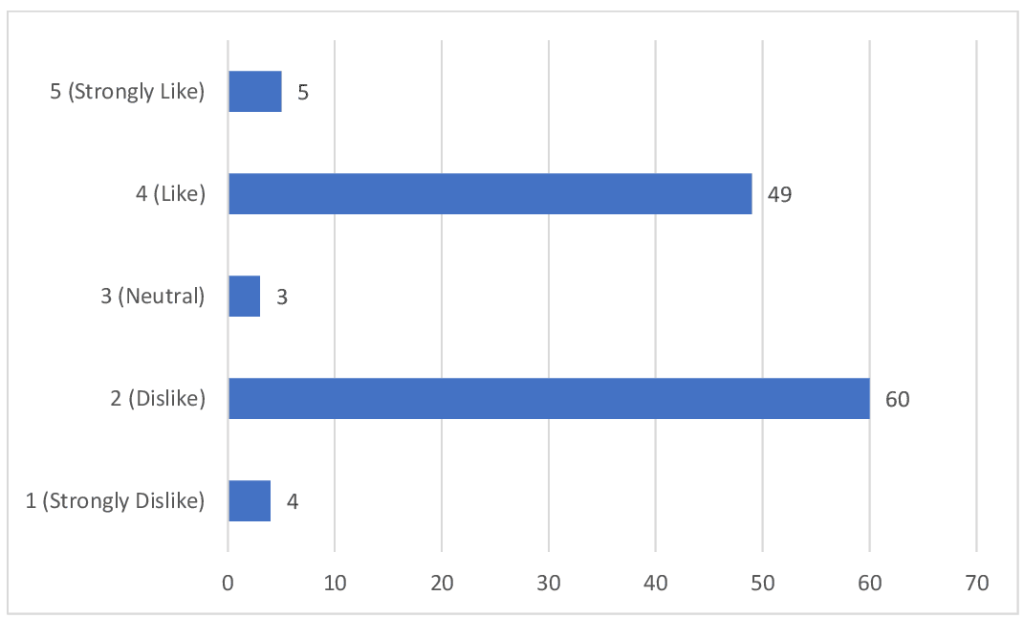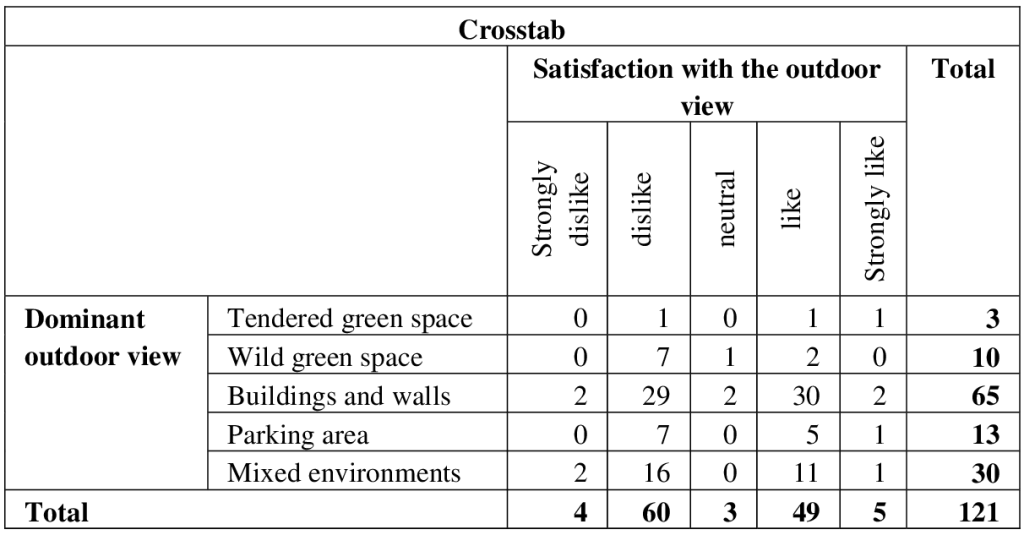|
Jointly published by The Division of General Studies, Chukwuemeka Odumegwu Ojukwu University, Nigeria (formerly Anambra State University) and Klamidas.com International Journal of General Studies (IJGS), Vol. 5, No. 1, March 2025. https://klamidas.com/ijgs-v5n1-2025-01/ |
|||||||||||
|
An Exploratory Study of the Therapeutic Value of Outdoor Environments in Psychiatric Hospitals in Southeast Nigeria Chijioke Chinyere Onwuzuligbo, Tochukwu Stephen Onyeyili & Ifeoma Josephine Nnaemeka ABSTRACT This exploratory study investigated the relationship between outdoor environmental features and patient satisfaction in psychiatric hospitals in Southeast Nigeria, a region experiencing rapid urbanisation, where cultural perceptions of nature’s therapeutic role may differ from Western contexts. A quantitative, cross-sectional survey was conducted across four psychiatric facilities, sampling 121 inpatients to assess their experiences and satisfaction with the outdoor environment. The findings revealed that the most common outdoor environment consisted of buildings and walls, with a generally neutral to slightly negative perception of the outdoor views among patients. Contrary to expectations based on theories like the Stress Reduction Theory, Theory of Supportive Design, and Biophilic Design Theory, no statistically significant association was found between the dominant outdoor views and patient satisfaction. The study, therefore, highlights the importance of socio-cultural influences which define patients’ preferences and perceptions of therapeutic environments. It suggests that social support and opportunities for family visits may be more critical to patient well-being in this context than the aesthetic qualities of outdoor views. The research also acknowledges the potential impact of varying levels of urbanisation and familiarity with natural settings on patients’ environmental perceptions. The study concludes that designing therapeutic outdoor spaces in Southeast Nigeria requires a nuanced approach that considers cultural, social, and individual factors, emphasising the need for accessible outdoor environments that foster social interaction and patient autonomy. Keywords: environmental psychology, social support, Igbo kinship, healthcare design, socio-cultural
INTRODUCTION The built environment is crucial in psychiatric healthcare, influencing patient recovery and overall well-being. Among the various environmental factors that may influence health and well-being, outdoor views and their associated landscapes are often considered therapeutic, supported by various theories that border on biophilia and environmental clues that reduce stress and provide support in diverse settings (Abraham et al., 2010; Umeora et al., 2023). This theoretical foundation has driven the adoption of biophilic design principles in mental health facilities and advocates for integrating natural elements to enhance patient healing (Totaforti, 2018; Nejade et al., 2022). Nevertheless, it is important to note that while theoretical frameworks strongly suggest a positive correlation between exposure to natural environments and improved mental health, the actual experiences of patients in real-world settings may deviate from these theoretical expectations given socio-cultural, geographic and economic differences (Slater, 2014; Rapoport, 1980; Herzog et al., 2000; Huang et al, 2022). Beyond buildings and the physical environment, various studies acknowledge the influence of social and cultural factors on other design aspects such as health and healthcare systems, product, communication, fashion etc (Hernandez & Blazer, 2006; Levesque & Li, 2014; Moalosi et al., 2010; Anyanwu & Chiana, 2022; Unwin, 2013). The increasing urbanisation in southeast Nigeria, as with other regions in the country, has resulted in the replacement of soft and green outdoor areas with hard and built-up scenery (Aliyu & Adamu, 2017; Egwuagu & Anikeze, 2024; Echeta et al., 2023a; 2023b). With a mix of soft and hard landscape features, psychiatric hospitals in Southeast Nigeria, a geographical location predominantly inhabited by the Igbo tribe, present a unique opportunity for investigating context-specific interpretations and interactions of patients with nature. In this region, psychiatric hospitals are situated in diverse urban, semi-urban, and rural settings where outdoor environments range from green spaces to highly built-up areas. Additionally, cultural perceptions of the therapeutic role of nature may differ from those in Western contexts, where much of the research on the patient-nature connection has been conducted. Unlike studies where decentralised nature integration is widely recognised and practised, mental healthcare in Nigeria still faces fundamental challenges of lack of understanding, institutional neglect, funding constraints and widespread stigma, all of which are reflected in the design of the facility and surrounding environments (Labinjo et al., 2020; Ogbonna et al., 2024; Onwuzuligbo, 2024). The theories underpinning this study are: Stress Reduction Theory (SRT) (Ulrich, 1984) which posits that exposure to restorative environments leads to physiological and psychological stress reduction, contributing to improved emotional states; Theory of Supportive Design (Ulrich, 1991; Andrade & Devlin, 2015) which emphasises that healthcare spaces should provide positive distractions, a sense of control, and opportunities for social interaction to optimise recovery; and Biophilic Design Theory (Kellert, 2006) that argues that humans have an innate affinity for nature, and integrating natural elements into built environments enhances psychological well-being. Put together, these theories frame the current study by suggesting that stressful spaces, such as healthcare environments, should offer visual design clues that promote autonomy, meaningful social interactions and positive distractions through restorative visual environmental features, thus leading to patient satisfaction. Despite the increasing discussions on the role of environmental factors in psychiatric care, there is limited empirical research assessing how specific environmental elements influence patient experiences in southeast Nigeria. Existing studies carried out in the country focused on the therapeutic value of the physical building in Northern Nigeria (Manga et al., 2023) and on the perceived therapeutic milieu from the staff’s point of view in Western Nigeria (Oluwatosin et al., 2021). There is, therefore, limited understanding of the extent to which the outdoor environment of psychiatric wards in Southeast Nigeria contributes to patient well-being, such that they are both effective and contextually appropriate. Thus, as an objective, the study seeks to determine the extent to which outdoor environmental features assumed to be beneficial in psychiatric settings contribute to patient satisfaction in Southeast Nigeria, by hypothesising that there is no significant relationship between the two. By so doing, the study will provide insights that contribute to both architectural design and mental healthcare planning, ensuring that environmental strategies align with the realities of psychiatric care in diverse socio-cultural settings. METHODS This study adopted a quantitative, cross-sectional research design. A structured survey was conducted in psychiatric hospitals across Southeast Nigeria, allowing for a comparative analysis of different environmental conditions. The study was conducted in four different types of hospitals, encompassing different ownership structures and hospital specialties. While ownership structure may influence funding, hospital types may influence the effects of deinstitutionalisation of mental healthcare (Anesi & Kerlin, 2021; Saldanha et al., 2013). All four facilities are located in 3 of the 5 states in southeast Nigeria, which are predominantly inhabited by the Igbos (one of the three major ethnic groups in Nigeria). The facilities included:
Of the 181 patients obtained from hospital records based on bed counts, 138 participants were sampled. Inclusion criteria included:
Data was collected using a structured questionnaire, which included items measuring patient experiences in relation to their hospital environment. The variables included:
The collected data was analysed using frequency distributions, and measures of central tendency to summarise patient responses, while the Chi-square test of independence was used to determine if environmental categories significantly influenced patient satisfaction with the outdoor view. Ethical approval was obtained from the individual hospitals before data collection took place. Informed consent was obtained from the individual participants, while confidentiality and anonymity were maintained throughout the period. RESULTS A total of 121 inpatients participated in the study, providing responses on their hospital outdoor environment and satisfaction with such views. The distribution of each variable is presented in Figures 1 and 2. The most common outdoor environment within the study area is made of buildings and walls (53.28%), while the least common is tendered green space (2.46%). Similarly, the median and mode for this variable DOEN remained buildings and walls.
When queried on satisfaction with their dominant outdoor view, the highest response was “dislike” at 49.59%, while the lowest was “neutral” at 2.48%. The mean PSOV score was 2.93, signifying a neutral to slightly negative overall perception. Similarly, the median and mode PSOV scores were 2 (dislike). The Chi-square test of independence was used to determine if the type of dominant outdoor environment significantly influenced patient satisfaction with the outdoor view. The results are shown in Tables 1 and 2. The cross-tabulation table, Table 1, shows how patient satisfaction is distributed across the different categories of dominant outdoor views. For instance, it was observed that the most prominent responses of likes (n = 30) and dislikes (n = 29) came from patients who viewed buildings and walls, suggesting the subjective nature of preferences and perception. From Table 2, the results show that the association between dominant outdoor view and patient satisfaction with the view was not statistically significant, χ2 (16, N = 121) = 15.80, p = 0.467> 0.05. Thus, the study does not have sufficient evidence to reject the null hypothesis initially stated. Table 1: Crosstabulation result of DOEN and PPOV
Table 2: Chi-Square test of independence result of DOEN and PPOV
DISCUSSION This study investigated the impact of dominant outdoor views on patient satisfaction in psychiatric hospitals in Southeast Nigeria. The aim was to determine if different outdoor environments, as characterised by their dominant views, were associated with patient satisfaction. The chi-square test of independence results revealed no statistically significant association between the dominant outdoor view and patient satisfaction with the view (χ2 (16, N = 121) = 15.80, p = 0.467). This result indicates that, within this sample, observed differences in patient satisfaction were not systematically related to the type of dominant outdoor view. These findings present a deviation from the general applicability of widely accepted assumptions in environmental psychology and healthcare architecture that the mere exposure to natural environments positively influences well-being as in several studies (Ulrich, 1984; Kaplan & Kaplan, 1989, as cited inMarkevych, 2017; Berto, 2014; van den Berg et al., 2003; Depledge et al., 2011; Wichrowski et al., 2021). This exception may be explained by the nuanced influences of patient characteristics. The complex, yet basic, human-environment relationship introduces a subjective interpretation of what is perceived as satisfactory. It is therefore important to acknowledge that the outdoor preferences and perceptions of what constitutes a “restorative” environment are not universal but are significantly shaped by socio-cultural backgrounds (Gifford, 2014; Milfont & Schultz, 2016; Hartig et al., 2011). Thus, emotional responses to places, including natural settings, are a product of person, place, and time. In the context of the current study, the dominant outdoor view categories might not hold the same aesthetic or restorative value nor elicit the same emotional responses, as they might in other cultural settings. For instance, cultural values related to nature, healing practices, or social interaction patterns might significantly influence what patients in Southeast Nigeria find satisfying in an outdoor view. This is supported by the idea that different cultures prioritise or value different visual elements in a landscape (Huang et al., 2022; Herzog, 2000). Furthermore, the socio-developmental-induced variations in familiarity with natural settings among the study participants, who were recruited from different locations in southeast Nigeria, may have also contributed to the findings (Herzog et al., 2000; Ewert et al., 2005). While the region includes some urban centres, the degree of urbanisation varies, and even within the urban areas, the nature of urbanisation may differ from that in highly industrialised nations, where studies underpinning SRT, TSD and BDT were conducted. In areas with higher urbanisation, individuals may have less frequent contact with nature, leading to altered perceptions and expectations of outdoor views and potentially a reduced sensitivity to the subtle differences in various types of green spaces (e.g., “tendered” vs. “wild”). This aligns with the concept that the benefits of nature can be affected by factors like the degree of urbanisation and people’s familiarity with natural settings (Ewert et al., 2005). Conversely, even patients residing in less urbanised areas might demonstrate varying levels of familiarity with specific types of natural environments, depending on factors such as socioeconomic status and individual experiences (Hartig et al., 2011; Ewert et al., 2005). The Theory of Supportive Design (TSD) provides another valuable lens through which the non-significant association observed between dominant outdoor views and patient satisfaction in this study can be interpreted. TSD posits that the built environment can significantly impact well-being by reducing stress, promoting coping, enhancing a sense of control, and promoting social support (Andrade & Devlin, 2015; Ulrich et al. 2018). In healthcare settings, this translates to designing spaces that facilitate healing and recovery by drawing on all available coping mechanisms. For the participants in the study area who are predominantly Igbos, the strong kinship and nuclear/extended family ties introduce a crucial nuance that defines meaningful social interactions. Among the Igbos, social support networks are paramount and serve as a primary source of resilience in stressful circumstances, suggested by works exploring Igbo social structures which emphasise the centrality of kinship and communal ties (Ekeopara, 2012; Layefa et al., 2022). Consequently, in the context of this study, the social environment within the psychiatric wards might exert a more profound influence on patients’ overall well-being and satisfaction than the physical indoor and outdoor environments. From a Supportive Design perspective, this suggests that design elements prioritising and facilitating social interaction, family visits, and community connections could be more critical in this cultural context than the aesthetic qualities of the view itself. For instance, patients might derive greater comfort and support from having spaces to accommodate family visits and communal activities, even with a less-than-ideal view, compared to having an aesthetically pleasing view but experiencing social isolation (Abubakar, 2015).Therefore, within the sampled facilities, it is possible that the outdoor spaces did not significantly impact patient satisfaction because such outdoor spaces may not have been designed to be easily accessed from the ward, thus limiting their social value. In essence, the design’s failure to support culturally preferred coping mechanisms and social support systems might have diminished its overall supportive function, overshadowing the influence of the visual environment. CONCLUSION AND RECOMMENDATION Based on the available data, the study concludes that patient satisfaction with outdoor spaces is influenced by an interplay of factors that extend beyond the mere visual characteristics of the view. Specifically, the study highlights the importance of considering socio-cultural influences on environmental perception, particularly in Southeast Nigeria, where cultural values and social structures may shape patients’ experiences and preferences in healthcare settings. The findings also underscore the potential impact of varying levels of urbanisation and familiarity with natural settings on how patients perceive and respond to outdoor environments in psychiatric wards. Furthermore, the study draws attention to the critical role of social support and kinship ties among the Igbo people, suggesting that design elements fostering social interaction may matter more in creating a therapeutic environment, regardless of the characteristics of the view. Therefore, when designing or renovating outdoor spaces in psychiatric wards in Southeast Nigeria, it is important to create avenues for patients to access outdoor environments, which also enhances the patients’ sense of autonomy. Enabling access to the outdoor environment strengthens culturally relevant coping mechanisms for psychiatric patients in the region. The study contributes valuable insights into the complexities of designing therapeutic outdoor environments for improved satisfaction in a specific socio-cultural context. It highlights the need to move beyond a one-size-fits-all approach and to consider the nuanced interplay of cultural, social, and individual factors in shaping patient experiences in psychiatric settings. To the best of our knowledge, this is a pioneer study investigating the association between outdoor environments and patient satisfaction in psychiatric hospital settings in Southeast Nigeria. It is therefore important to mention possible methodological limitations to this exploratory study. First, even though patients were recruited based on the nurses’ cognitive assessments, it is possible their responses were influenced by their fluctuating mental state, diagnosis, medications, and length of stay. Secondly, the study’s cross-sectional design limits the ability to infer causality, and it did not employ a mixed methodology by adding a qualitative method for data collection. The philosophy guiding the study is positivism, where the researcher set out to quantitatively study psychiatric patients’ assessment of their environment. Therefore, while this approach was appropriate for the study’s aims, the study may have benefited, in a different way, from deeper insights afforded by qualitative methods of data collection as an added methodology. Furthermore, patient satisfaction was measured using a single-item measure, which may not fully capture the complexity of this construct. It therefore behoves the scholarly community to investigate the study objective while considering these limitations. DECLARATIONS Ethical clearance Ethical clearance was obtained from each of the four participating hospitals, while the study participants consented to participate voluntarily in the study. Participants were also made to understand that the exercise was purely for academic purposes. Acknowledgements Data for this study were collected as part of a wider study assessing the physical environment of psychiatric facilities in southeast Nigeria on staff and patient outcomes. As such, the authors acknowledge the management of the participating hospitals for permitting the corresponding author to carry on with the data collection process. Again, the authors sincerely thank the nurses who were instrumental during the process. Sources of funding The authors received no financial support for this article’s research, authorship, or publication. Conflict of Interest The authors declare no potential conflicts of interest concerning the research, authorship, and publication of this article. Availability of data and materials The datasets on which conclusions were made for this study are available on reasonable request. REFERENCES Abraham, A., Sommerhalder, K., & Abel, T. (2010). Landscape and well-being: a scoping study on the health-promoting impact of outdoor environments. International journal of public health, 55, 59-69. https://doi.org/10.1007/s00038-009-0069-z Abubakar, A. I. (2015). Familial Caregiving Architectural Provision in Nigerian Hospital Wards (Doctoral dissertation, Universiti Teknologi Malaysia). https://eprints.utm.my/54820/1/AlkaliIbrahim AbubakarPFAB 2015.pdf Aliyu, A. A., & Amadu, L. (2017). Urbanization, Cities, and Health: The Challenges to Nigeria – A Review. Annals of African Medicine, 16(4), 149. https://doi.org/10.4103/aam.aam_1_17 Andrade, C. C., & Devlin, A. S. (2015). Stress reduction in the hospital room: Applying Ulrich’s theory of supportive design. Journal of environmental psychology, 41, 125-134. https://doi.org/10.1016/j. jenvp.2014.12.001 Anesi, G. L., & Kerlin, M. P. (2021). The impact of resource limitations on care delivery and outcomes: routine variation, the coronavirus disease 2019 pandemic, and persistent shortage. Current opinion in critical care, 27(5), 513-519. https://doi.org/10.1097/MCC. 0000000000000859 Anyanwu, E. C., & Chiana, C. A. (2022). Socio-Cultural Influences on Fashion Consumption Behaviour of University Students. ARRUS Journal of Social Sciences and Humanities, 2(1), 47-65. https://doi.org/10.35877/ soshum735 Echeta, I. B., Olotuah, A. O., Ezeji, K. E., & Onwuzuligbo, C. C. (2023a). Effect of geometry of shading devices on quantity of indoor heat gain in residential buildings in Southeast Nigeria: A case study of Owerri. African Journal of Environmental Research, 4(1). 94-109. https://www.researchgate.net/publication/369071410 Echeta, I. B., Ezeji, K. E., Onwuzuligbo, C. C., & Nwoke, I. O. (2023b). Impact of materials used in construction of shading devices on quantity of indoor heat gain in residential buildings in Owerri, Nigeria. African Journal of Environmental Research, 4(2). 54-66. https://www.researchgate.net/publication/373989365 Egwuagu, U. B., & Anikeze, N. H. (2024). Urbanization and youth employment in South East of Nigeria: 2015–2023. NG Journal of Social Development, 13(1), 235-248. https://dx.doi.org/10.4314/ ngjsd.v13i1.18 Ekeopara, C. A. (2012). The Impact of the extended family system on socio-ethical order in Igboland. American Journal of Social Issues & Humanities, 2(4), 262-267. https://citeseerx.ist.psu.edu/document? repid=rep1&type=pdf&doi=1f6d61a9c1f33ad93e62a80f2f8c3ca72572c766 Ewert, A., Place, G., & Sibthorp, J. (2005). Early-life outdoor experiences and an individual’s environmental attitudes. Leisure Sciences, 27(3), 225-239. https://doi.org/10.1080/01490400590930853 Gifford, R. (2014). Environmental psychology matters. Annual review of psychology, 65(1), 541-579. https://doi.org/10.1146/annurev-psych-010213-115048 Hartig, T., Van Den Berg, A. E., Hagerhall, C. M., Tomalak, M., Bauer, N., Hansmann, R., … & Waaseth, G. (2011). Health benefits of nature experience: Psychological, social and cultural processes. Forests, trees and human health, 127-168. https://doi.org/10.1007/978-90-481-9806-1_5 Hernandez, L. M., & Blazer, D. G. (2006). The impact of social and cultural environment on health. In Genes, behavior, and the social environment: Moving beyond the nature/nurture debate. National Academies Press (US). https://www.ncbi.nlm.nih.gov/books/ NBK19932/ Herzog, T. R., Herbert, E. J., Kaplan, R., & Crooks, C. L. (2000). Cultural and Developmental Comparisons of Landscape Perceptions and Preferences. Environment and Behavior. https://doi.org/10.1177/ 0013916500323002 Huang, T., Leung, A. K. Y., Eom, K., & Tam, K. P. (2022). Important to me and my society: How culture influences the roles of personal values and perceived group values in environmental engagements via collectivistic orientation. Journal of Environmental Psychology, 80, 101774. https://doi.org/10.1016/j.jenvp.2022. 101774 Kellert, S. R. (2006). Building for life: Designing and understanding the human-nature connection. Renewable Resources Journal, 24(2), 8.https://www.researchgate.net/profile/Stephen-Kellert-2/publication /40777405 Keniger, L. E., Gaston, K. J., Irvine, K. N., & Fuller, R. A. (2013). What are the Benefits of Interacting with Nature? International Journal of Environmental Research and Public Health, 10(3), 913-935. https://doi.org/10.3390/ijerph100 30913 Labinjo, T., Serrant, L., Ashmore, R., & Turner, J. (2020). Perceptions, attitudes and cultural understandings of mental health in Nigeria: a scoping review of published literature. Mental Health, Religion & Culture, 23(7), 606–624. https://doi.org/10.1080/13674676. 2020.1726883 Layefa, G., Ezenagu, N., & Esoso-Agbor, J. (2022). Revisiting kinship in contemporary West African societies: The case of role-relationship. F1000Research, 11, 965. https://doi.org/10.12688/f1000research .76054.1 Levesque, A., & Li, H. Z. (2014). The relationship between culture, health conceptions, and health practices: A qualitative–quantitative approach. Journal of cross-cultural psychology, 45(4), 628-645. https://doi.org/10.1177/002202211351 9855 Manga, P. M., Yamte, V. J., & Yawate, V. E. (2023). A Critical Examination of the Therapeutic Architecture Potentials at the Psychiatric Hospital Yola, Nigeria. Savannah Journal of Science and Engineering Technology, 1(4), 153–159. Retrieved from https://www.sajsetjournal.com.ng/index.php/ journal/article/view/56 Markevych, I., Schoierer, J., Hartig, T., Chudnovsky, A., Hystad, P., Dzhambov, A. M., De Vries, S., Triguero-Mas, M., Brauer, M., Nieuwenhuijsen, M. J., Lupp, G., Richardson, E. A., Astell-Burt, T., Dimitrova, D., Feng, X., Sadeh, M., Standl, M., Heinrich, J., & Fuertes, E. (2017). Exploring pathways linking greenspace to health: Theoretical and methodological guidance. Environmental Research, 158, 301-317. https://doi.org/10.1016/j.envres.2017.06.028 Milfont, T. L., & Schultz, P. W. (2016). Culture and the natural environment. Current Opinion in Psychology, 8, 194-199. https://doi.org/10.1016/j.copsyc.2015 .09.009 Moalosi, R., Popovic, V., & Hickling-Hudson, A. (2010). Culture-orientated product design. International journal of technology and design education, 20, 175-190. https://doi.org/10.1007/s10798-008-9069-1 Nejade, R. M., Grace, D., & Bowman, L. R. (2022). What is the impact of nature on human health? A scoping review of the literature. Journal of global health, 12, 04099. Ogbonna, C. K., Azubuike, P. C., Enyam, M. O., Odo, O. J., & Nwadiche, M. (2024). Addressing stigma to achieve healthcare equity and universal health coverage in Nigeria. Discover Global Society, 2(1), 73. https://doi.org/10.1007 /s44282-024-00104-1 Oluwatosin, O. B., Chinedu, A. C., & Abimbola, O. E. (2021). Perceived Effects of Therapeutic Milieu on the Recovery of Depressive Patients among Nurses at Neuropsychiatric Hospital Aro, Abeokuta, South-West, Nigeria. Journal of Medical and Dental Science Research, 8(9), 57-66. https://tinyurl.com/4kpmdnex Onwuzuligbo, C. C. (2024). Influence of Ward Spatial Features on Staff Activities of Healthcare Delivery in Public Tertiary Mental Health Facilities in Southeast Nigeria. Journal of Medicine, Engineering, Environmental and Physical Sciences (JOMEEPS), 2(1), 7-20. https://klamidas.com/jomeeps-v2n1-2024-01. https://www.researchgate.net /publication/380319958 Rapoport, A. (1980). Cross-cultural aspects of environmental design. In Environment and culture (pp. 7-46). Boston, MA: Springer US. https://doi.org/10.1007/978-1-4899-0451-5_2 Saldanha, D., Bhattacharya, L., Daw, D., & Chaudari, B. (2013). Origin and development of general hospital psychiatry. Medical Journal of Dr. DY Patil University, 6(4), 359-365. https://doi.org/10.4103/0975-2870.118266 Slater, B. (2014).Designing Abroad_ Cultural Considerations In Evidence-Based Design. Healthcare Design Magazine. https://healthcaredesign magazine.com/trends/architecture/designing-abroad-cultural-considerations -evidence-based-design/ Totaforti, S. (2018). Applying the benefits of biophilic theory to hospital design. City, Territory and Architecture, 5, 1-9. https://doi.org/ 10.1186/s40410-018-0077-5 Ulrich, R. S. (1984). View through a window may influence recovery from surgery. Science, 224(4647), 420-421. https://doi.org/6143402 Ulrich, R. S., Bogren, L., Gardiner, S. K., & Lundin, S. (2018). Psychiatric ward design can reduce aggressive behavior. Journal of Environmental Psychology, 57, 53-66. https://doi.org/10.1016/j. jenvp.2018.05.002 Umeora, C. O., Okoye, B. S. A., Ifebi, O. C., & Onwuzuligbo, C. C. (2023). Appraising landscaping in Chukwuemeka Odumegwu Ojukwu University, Uli campus, Anambra State, Nigeria. Global Online Journal of Academic Research, Vol. 2(1). Accessed https://nigerianjournalsonline.com /index.php/JOMEEPS/article/view/3812 Unwin, Stephen. (2013). How Culture Affects Advertising Expression and Communication Style Journal of Advertising. 3. 24-27. https://doi.org/10.1080/00913367.1974.10672524
|
|||||||||||





